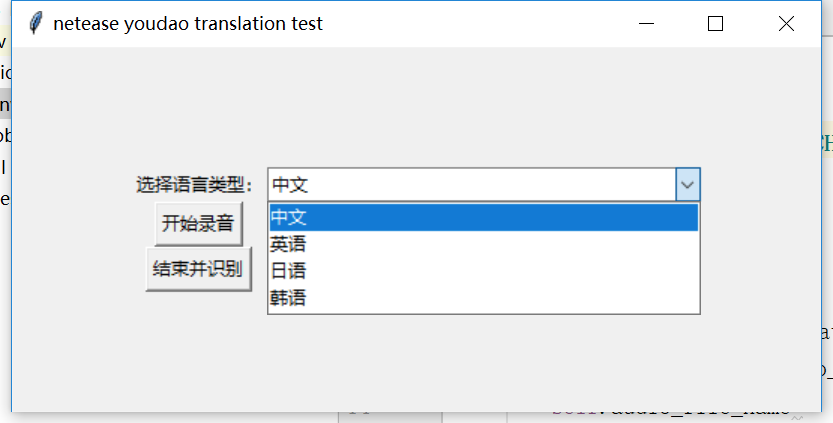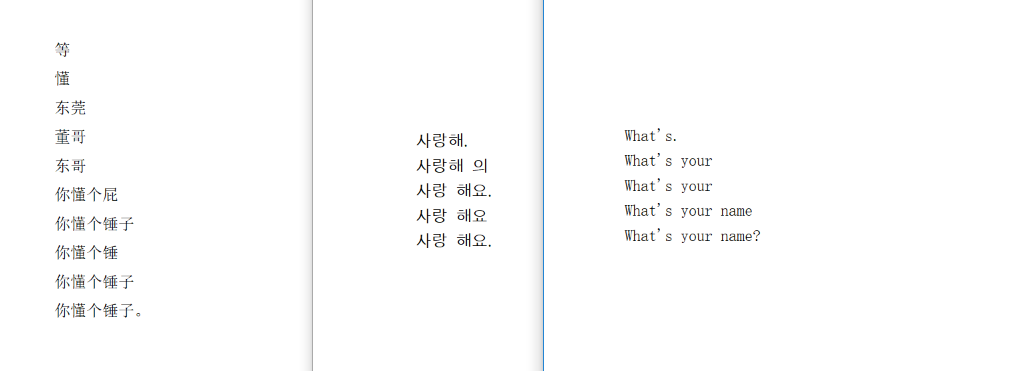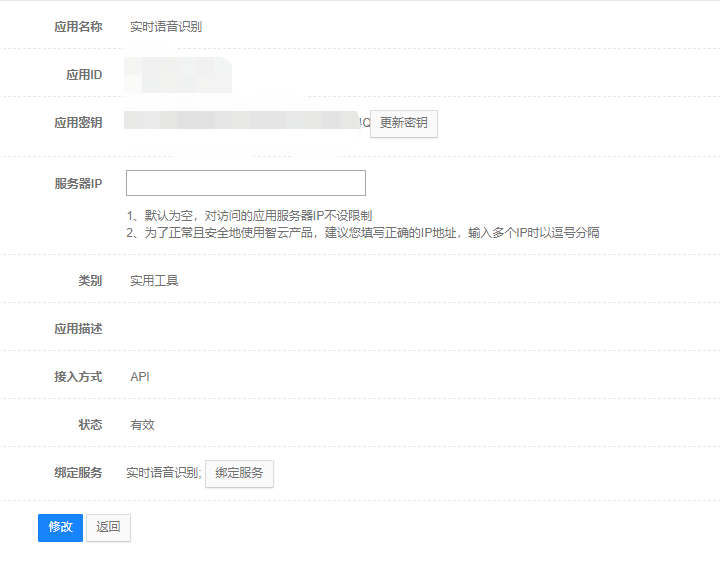您好,登錄后才能下訂單哦!
您好,登錄后才能下訂單哦!
本篇文章為大家展示了使用python如何開發翻譯工具,內容簡明扼要并且容易理解,絕對能使你眼前一亮,通過這篇文章的詳細介紹希望你能有所收獲。
效果展示
先看看界面和結果哈:
可以選擇多種語音,這里只寫了四種常見的:

偶分別測試的中文、韓文、英文。看著還不錯哦~

調用API接口的準備工作
首先,是需要在有道智云的個人頁面上創建實例、創建應用、綁定應用和實例,獲取調用接口用到的應用的id和密鑰。具體個人注冊的過程和應用創建過程詳見文章分享一次批量文件翻譯的開發過程

開發過程詳細介紹
下面介紹具體的代碼開發過程。
首先是根據實時語音識別文檔來分析接口的輸入輸出。接口設計的目的是對連續音頻流的實時識別,轉換成文本信息并返對應文字流,因此通信采用websocket,調用過程分為認證、實時通信兩階段。
在認證階段,需發送以下參數:
| 參數 | 類型 | 必填 | 說明 | 示例 |
|---|---|---|---|---|
| appKey | String | 是 | 已申請的應用ID | ID |
| salt | String | 是 | UUID | UUID |
| curtime | String | 是 | 時間戳(秒) | TimeStamp |
| sign | String | 是 | 加密數字簽名。 | sha256 |
| signType | String | 是 | 數字簽名類型 | v4 |
| langType | String | 是 | 語言選擇,參考支持語言列表 | zh-CHS |
| format | String | 是 | 音頻格式,支持wav | wav |
| channel | String | 是 | 聲道,支持1(單聲道) | 1 |
| version | String | 是 | api版本 | v1 |
| rate | String | 是 | 采樣率 | 16000 |
簽名
sign生成方法如下:
signType=v4;
sign=sha256(應用ID+salt+curtime+應用密鑰)。
認證之后,就進入了實時通信階段,發送音頻流,獲取識別結果,最后發送結束標志結束通信,這里需要注意的是,發送的音頻最好是16bit位深的單聲道、16k采樣率的清晰的wav音頻文件,這里我開發時最開始因為音頻錄制設備有問題,導致音頻效果極差,接口一直返回錯誤碼304(手動捂臉)。
Demo開發:
這個demo使用python3開發,包括maindow.py,audioandprocess.py,recobynetease.py三個文件。界面部分,使用python自帶的tkinter庫,來進行語言選擇、錄音開始、錄音停止并識別的操作。audioandprocess.py實現了錄音、音頻處理的邏輯,最后通過recobynetease.py中的方法來調用實時語音識別API。
1.界面部分:
主要元素:
root=tk.Tk()
root.title("netease youdao translation test")
frm = tk.Frame(root)
frm.grid(padx='80', pady='80')
# label1=tk.Label(frm,text="選擇待翻譯文件:")
# label1.grid(row=0,column=0)
label=tk.Label(frm,text='選擇語言類型:')
label.grid(row=0,column=0)
combox=ttk.Combobox(frm,textvariable=tk.StringVar(),width=38)
combox["value"]=lang_type_dict
combox.current(0)
combox.bind("<<ComboboxSelected>>",get_lang_type)
combox.grid(row=0,column=1)
btn_start_rec = tk.Button(frm, text='開始錄音', command=start_rec)
btn_start_rec.grid(row=2, column=0)
lb_Status = tk.Label(frm, text='Ready', anchor='w', fg='green')
lb_Status.grid(row=2,column=1)
btn_sure=tk.Button(frm,text="結束并識別",command=get_result)
btn_sure.grid(row=3,column=0)
root.mainloop()2.音頻錄制部分,引入pyaudio庫(需通過pip安裝)來調用音頻設備,錄制接口要求的wav文件,并通過wave庫存儲文件:
def __init__(self, audio_path, language_type,is_recording):
self.audio_path = audio_path,
self.audio_file_name=''
self.language_type = language_type,
self.language=language_dict[language_type]
print(language_dict[language_type])
self.is_recording=is_recording
self.audio_chunk_size=1600
self.audio_channels=1
self.audio_format=pyaudio.paInt16
self.audio_rate=16000
def record_and_save(self):
self.is_recording = True
# self.audio_file_name=self.audio_path+'/recordtmp.wav'
self.audio_file_name='/recordtmp.wav'
threading.Thread(target=self.record,args=(self.audio_file_name,)).start()
def record(self,file_name):
print(file_name)
p=pyaudio.PyAudio()
stream=p.open(
format=self.audio_format,
channels=self.audio_channels,
rate=self.audio_rate,
input=True,
frames_per_buffer=self.audio_chunk_size
)
wf = wave.open(file_name, 'wb')
wf.setnchannels(self.audio_channels)
wf.setsampwidth(p.get_sample_size(self.audio_format))
wf.setframerate(self.audio_rate)
# 讀取數據寫入文件
while self.is_recording:
data = stream.read(self.audio_chunk_size)
wf.writeframes(data)
wf.close()
stream.stop_stream()
stream.close()
p.terminate()3.翻譯接口調用部分:
def recognise(filepath,language_type):
global file_path
file_path=filepath
nonce = str(uuid.uuid1())
curtime = str(int(time.time()))
signStr = app_key + nonce + curtime + app_secret
print(signStr)
sign = encrypt(signStr)
uri = "wss://openapi.youdao.com/stream_asropenapi?appKey=" + app_key + "&salt=" + nonce + "&curtime=" + curtime + \
"&sign=" + sign + "&version=v1&channel=1&format=wav&signType=v4&rate=16000&langType=" + language_type
print(uri)
start(uri, 1600)
def encrypt(signStr):
hash = hashlib.sha256()
hash.update(signStr.encode('utf-8'))
return hash.hexdigest()
def on_message(ws, message):
result=json.loads(message)
try:
resultmessage1 = result['result'][0]
resultmessage2 = resultmessage1["st"]['sentence']
print(resultmessage2)
except Exception as e:
print('')
def on_error(ws, error):
print(error)
def on_close(ws):
print("### closed ###")
def on_open(ws):
count = 0
file_object = open(file_path, 'rb')
while True:
chunk_data = file_object.read(1600)
ws.send(chunk_data, websocket.ABNF.OPCODE_BINARY)
time.sleep(0.05)
count = count + 1
if not chunk_data:
break
print(count)
ws.send('{\"end\": \"true\"}', websocket.ABNF.OPCODE_BINARY)
def start(uri,step):
websocket.enableTrace(True)
ws = websocket.WebSocketApp(uri,
on_message=on_message,
on_error=on_error,
on_close=on_close)
ws.on_open = on_open
ws.run_forever()上述內容就是使用python如何開發翻譯工具,你們學到知識或技能了嗎?如果還想學到更多技能或者豐富自己的知識儲備,歡迎關注億速云行業資訊頻道。
免責聲明:本站發布的內容(圖片、視頻和文字)以原創、轉載和分享為主,文章觀點不代表本網站立場,如果涉及侵權請聯系站長郵箱:is@yisu.com進行舉報,并提供相關證據,一經查實,將立刻刪除涉嫌侵權內容。